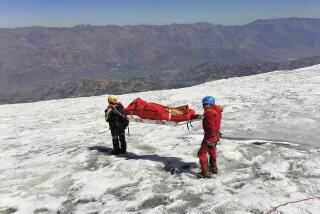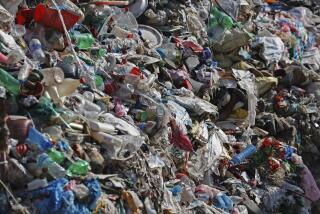Inca Mummies Discovered Under Lima Shantytown
- Share via
The emergency excavation of a 500-year-old cemetery under a Lima shantytown has produced the largest trove of Inca mummies ever discovered in Peru--a finding that already is changing established views of Inca society.
Archeologists have unearthed more than 2,200 remarkably well-preserved mummies, some in bundles containing as many as seven individuals. The find includes some 60,000 artifacts--including textiles, wooden implements, pottery and burial gifts--that will provide a wealth of new information about the short-lived Inca empire.
The finding dwarfs previous discoveries in Peru, which have produced only handfuls of mummies from any one site.
“This is a fabulous find, in part because of the extraordinary preservation of the mummy bundles and in part because it is such a large sample,” said archeologist Christopher P. Donnan of UCLA, who was not involved in the excavation effort. “We really don’t have anything comparable to it.”
The sprawling 20-acre cemetery was a central burial site for the Inca people from about AD 1480 to 1533, when Spanish fortune hunter Francisco Pizarro and his troops--and cannons--destroyed the fledgling empire.
The mummies and artifacts at the site, called Puruchuco-Huaquerones, were in imminent danger because peasants who have fled to the shantytown in recent years to escape guerrilla warfare in Peru’s highlands are dumping as much as 60,000 gallons of sewage and other liquids onto the bone-dry soil every day. The moisture is destroying the buried bodies and other organic materials that were preserved for five centuries by desiccation and the arid climate.
“If we had started five years from now, we would have found only bones,” said Peruvian archeologist Guillermo “Willy” Cock, who led the excavations. Cock, 48, is a graduate student at UCLA and a research associate at the school’s Fowler Museum of Cultural History.
As it is, the team was able to retrieve only a fraction of the mummies buried at the site before running out of time and money. In the last areas where they excavated, Cock said, the mummies were decomposing “with worms and insects, as if they had died 45 days before, not 500 years before. . . . It was not a pretty sight.”
A Cross-Section of Inca Society
The finds were revealed Wednesday in a news conference at the National Geographic Society, which provided emergency funds to carry out the excavation. The excavation will be featured in the May National Geographic magazine and in a May 15 television special on PBS. Further information is also available online at www.nationalgeographic.com/inca.
The discovery is particularly valuable because it includes a cross-section of Inca society, from crude peasant burials to the elaborate mummies of the elite. And unlike elite mummies from most previous excavations, these have not been pillaged by looters.
As the findings are cataloged and studied, “we are going to rewrite Inca history,” Cock said.
Because of the press of excavation, the team so far has opened only three of the mummy bundles. But already, the finds “are telling some amazing stories,” Cock said.
Some of the pottery from the burials, for example, comes from hundreds of miles to the north and south of Lima, indicating that the Inca empire was more highly integrated than researchers had previously believed.
“We always thought that they were in a structure imposed over local ethnic groups [by the ruling Inca] and that the people in general were not integrating Inca culture into their everyday lives,” Cock said.
“What we have found is evidence of the opposite. The common people were becoming a part of the Inca society, rather than being kept marginal, as was assumed.
“Ethnic differences were disappearing, perhaps for the first time,” he added. “In modern terms, they were developing a sense of nation.”
But the intrusion of the Spanish cut that effort short, Cock added. “There was not enough time to integrate the entire country.”
Individual skeletons disturbed by looters or by construction are also being studied.
“That’s already shedding light on the diet and general health conditions of the population,” Donnan said. “There’s clear evidence of malnutrition among some of the children.”
Researchers do not yet understand what led to the malnutrition or what it implies about Inca society.
Cock’s team was able to excavate only in the streets of the shantytown and in other open spaces, such as the local schoolyard. The team needed to build bridges over the trenched streets so that peasants could cross in front of their homes. Many of the locals were hired to work on the project.
Cock estimates that the team was able to extract only about 20% of the mummies in the cemetery. The rest are under houses and other structures and are rapidly being destroyed by the influx of water.
The remaining mummies cannot be recovered, Cock said at the news conference. The researchers have exhausted their financial resources, and the 1,240 families of the shantytown have secured permission to remain on the site.
“Having to walk away is frustrating,” he said. “What’s left may have been a huge contribution to knowledge of the Inca.”
But what was removed will also have a massive impact, said other experts.
“What’s most important is the tremendous size of the collection, 2,200 bodies,” said archeologist John W. Verano of Tulane University, who, like Donnan, was not involved in the rescue effort. “For an archeological site in South America, that is a huge sample.
“That’s significant because you can say so much more if you have a large representative sample of the burial population. You can talk about mortality patterns, life expectancy, burial practices, health, disease, causes of death, etc.”
Some of the mummy bundles weigh hundreds of pounds and hold as many as seven individuals, along with their possessions.
The simplest bundles have wrappings of elaborate textiles around an individual and his possessions. In others, the individual mummies are separated from each other with stuffing, then the entire bundle is enclosed in textiles and often, on top of that, an elaborate net made of rope.
‘Cotton King’ Was Buried With Infant
One bundle, christened the Cotton King, was made up of 300 pounds of raw cotton. Inside was the body of an Inca noble and a baby, probably related. They were accompanied by 70 items, including food, pottery, animal skins and corn to make a fermented drink called chicha.
Forty of the bundles are so-called falsas cabezas or “false heads,” having a cotton-filled protuberance on top to mimic a head. Some are adorned with a metal mask or a wig made of vegetable fibers and dyed black.
The falsas cabezas contain several individuals: one of them the principal person and the others presumably accompanying him in the afterlife. The bodies of the adults are in the fetal position, the classic Inca burial posture, with their possessions arranged around them.
There is no evidence indicating whether the accompanying individuals are servants or relatives, Cock said, and no suggestion that they were killed when the principal died. Apparently, bodies were kept until the entire group was dead, at which time they were buried.
The mummy bundles, said archeologist Johan Reinhard of the Mountain Institute, a National Geographic explorer-in-residence, “are like time capsules from the Inca.”
More to Read
Sign up for Essential California
The most important California stories and recommendations in your inbox every morning.
You may occasionally receive promotional content from the Los Angeles Times.













